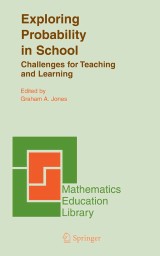Details

Exploring Probability in School
Challenges for Teaching and LearningMathematics Education Library, Band 40
|
106,99 € |
|
| Verlag: | Springer |
| Format: | |
| Veröffentl.: | 30.03.2006 |
| ISBN/EAN: | 9780387245300 |
| Sprache: | englisch |
| Anzahl Seiten: | 390 |
Dieses eBook enthält ein Wasserzeichen.
Beschreibungen
<p><strong>Exploring Probability in School</strong> provides a new perspective into research on the teaching and learning of probability. It creates this perspective by recognizing and analysing the special challenges faced by teachers and learners in contemporary classrooms where probability has recently become a mainstream part of the curriculum from early childhood through high school. The authors of the book discuss the nature of probability, look at the meaning of probabilistic literacy, and examine student access to powerful ideas in probability during the elementary, middle, and high school years. Moreover, they assemble and analyse research-based pedagogical knowledge for teachers that can enhance the learning of probability throughout these school years.</p> <p>With the book’s rich application of probability research to classroom practice, it will not only be essential reading for researchers and graduate students involved in probability education; it will also capture the interest of educational policy makers, curriculum personnel, teacher educators, and teachers.</p>
Perspectives on Probability and Probability Education.- The Nature of Chance and Probability.- Towards "Probability Literacy" for all Citizens: Building Blocks and Instructional Dilemmas.- An Overview of Research into the Teaching and Learning of Probability.- Teaching and Learning Probability in the Elementary School.- Characteristics of Elementary School Students' Probabilistic Reasoning.- Combinatorics and the Development of Children's Combinatorial Reasoning.- Teaching and Learning Probability in the Middle School.- The Probabilistic Reasoning of Middle School Students.- How do Teachers Foster Students' Understanding of Probability?.- Dealing with Compound Events.- How Can Teachers Build Notions of Conditional Probability and Independence?.- Teaching and Learning Probability in the High School.- What is the Nature of High School Students' Conceptions and Misconceptions About Probability?.- Probability and Statistical Inference: How Can Teachers Enable Learners to Make the Connection?.- Teachers and Probability.- Teaching and Learning the Mathematization of Uncertainty: Historical, Cultural, Social and Political Contexts.- Assessing Probabilistic Thinking and Reasoning.- Probability in Teacher Education and Development.- Reflections.
<p>Graham Jones has taught at universities in Australia and the United State for more than 35 years after commencing his career as a teacher in both elementary schools and high schools. He was the first pro-vice-chancellor at Griffith University, Gold Coast Campus and is an Emeritus Professor at that university and at Illinois State University, Normal, United States. </p> <p></p> <p>His research into cognitive aspects of probability started more than 30 years ago at Indiana University, United States, where his PhD. dissertation focused on the probabilistic reasoning of primary-aged children. His subsequent research into the learning and teaching of probability and data exploration has featured the development and validation of cognitive frameworks and the use of these frameworks to inform instruction and assess student learning. Recent articles on this research with other colleagues have appeared in the following journals: Educational Studies in Mathematics (1997, pp. 101-125), Mathematics Education Research Journal (1997, pp. 39-59), Journal for Research in Mathematics Education (1999, pp. 487-519), Mathematical Thinking and Learning (2000, pp. 269-308), Journal of Mathematical Behavior (2001, 109-144) and the Canadian Journal of Science, Mathematics, and Technology Education (2002, 221-236). This research is further discussed in chapters that have been written for the International handbook of research in mathematics education [L. English (Ed.), (2002), Lawrence Erlbaum] and The challenge of developing statistical literacy, reasoning and thinking [D. Ben-Zvi & J. Garfield (Eds.), (2004), Kluwer Academic] </p> <p></p> <p>Graham has also co-authored several books on the teaching of probability and statistics at various levels of the educational spectrum: Data, chance and probability (a three-part series for Grades 1 through 8 published by Learning Resources), Algebra, data and probability explorations for the middle school: A graphics calculator approach (Dale Seymour Publications), and Investigating probability and statistics: Using the TI-82 graphics calculator (Addison-Wesley). </p> <p></p> <p>He was the first president of the Mathematics Education Research of Australasia (MERGA) and is a life member of that organization. He is a Fellow of the Australian College of Education and the Australian Institute of Management and is also recognized in Who’s Who in Australia and Who’s Who in America. He has served on the editorial panels of several research journals: Journal for Research in Mathematics Education, Mathematical Thinking and Learning, Mathematics Education Research Journal, and the Mathematics Educator. Graham’s address is: School of Education and Professional Studies, Griffith University, Gold Coast Campus, PMB 50 Gold Coast Mail Centre, Queensland 9726, Australia. E-mail: g.jones@griffith.edu.au</p>
<p><em>Exploring Probability in School</em> provides a new perspective into research on the teaching and learning of probability. It creates this perspective by recognizing and analysing the special challenges faced by teachers and learners in contemporary classrooms where probability has recently become a mainstream part of the curriculum from early childhood through high school. The authors of the book discuss the nature of probability, look at the meaning of probabilistic literacy, and examine student access to powerful ideas in probability during the elementary, middle, and high school years. Moreover, they assemble and analyse research-based pedagogical knowledge for teachers that can enhance the learning of probability throughout these school years. </p> <p></p> <p>With the book’s rich application of probability research to classroom practice, it will not only be essential reading for researchers and graduate students involved in probability education; it will also capture the interest of educational policy makers, curriculum personnel, teacher educators, and teachers. </p>
Examines key aspects of research into the teaching and learning of probability in the light of its recent introduction into the school curriculum at all grade levels Addresses the manifold nature of probability and asks what it means for children and adults to be probabilistically literate
Diese Produkte könnten Sie auch interessieren:

Erlebnispädagogik in der Grundschule

von: Marcus Weber, Werner Michl, Holger Seidel, Janne Fengler

22,99 €















